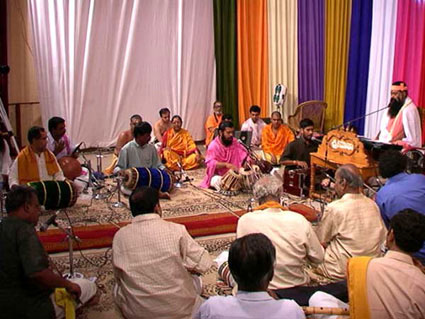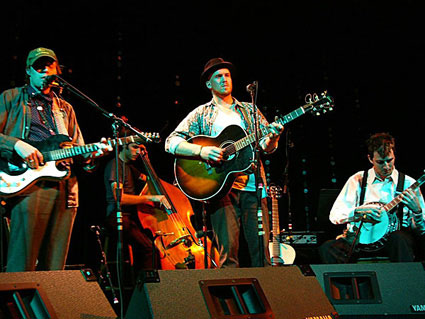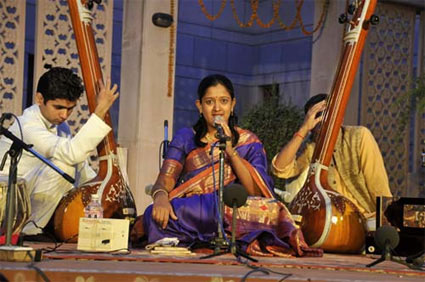"After silence that which comes nearest to expressing the inexpressible is music."-Aldous Huxley We all know the power of music. The passionate words of the national anthem, the ethereal notes of classical music, the soothing rhymes of childhood lullabies—music can truly uplift, inspire, enlighten, soothe, and entertain, all at the same time. Musicians such as Tansen were believed to be able to light lamps simply by the power of their voice. Often said to be the food of gods, music is, no doubt, powerful. In fact, people across the world have made use of music to express or evoke the deepest religious experiences. In this articleClassical MusicWhat are Bhajans?InfluencesInstruments Used in BhajansHow to Organise a Bhajan Group Classical Music In medieval India, during the reign of the Moghuls, the strong tides of the Bhakti (devotion) movement swept across the country. An essential feature of this movement was the use of devotional songs called bhajans to come closer to God and attain mystic states of intense ecstasy. Unlike the complicated rituals of the Vedic era, worship in the Bhakti tradition mainly comprised music and songs, which are not intellectualised and were typically in the common regional languages of India. This made it possible for the masses to approach God in their own way, without a mediator such as a priest, or knowledge of ancient languages such as Sanskrit. What are Bhajans? Bhajans are devotional songs that typically praise God, recite an anecdote, or preach the teachings of saints. Another related word is kirtan, which typically refers to musical chanting of mantras mostly from the Vedas. Devotional songs in Sikhism are also called kirtans. Influences Bhajans have been influenced at various times by the teachings of saints such as Chaitanya, Haridas, Tulsidas, Soordas, Mira, and Kabir, whose songs are still sung today. They form a part of contemporary Hinduism. The qawwalis (devotional songs sung by Sufi mystics) have also influenced the way bhajans are sung in some parts of the country. Instruments Used in Bhajans The musical instruments may include the following: Kartal - wooden clappers Ektar - one-stringed lute Dotar - two-stringed lute Manjira - small hand cymbals Sitar - long-necked lute Dholak - barrel-shaped drum Nal - barrel-shaped drum Tabla - hand drums Harmonium - hand-pumped organ How to Organise a Bhajan Group Do you want to organise a bhajan group with your family members and friends? Here are some tips to bear in mind. Organise a group: Bhajans are best sung in groups. Typically, in India, bhajans are a way of social bonding with people irrespective of caste, gender, or class. Organise a group of like-minded people in your neighbourhood, and hold regular sessions at a time convenient for everyone. Choose a venue: The bhajan sessions could be conducted at the homes of different members by rotation. However, in some countries, neighbours may perceive it as a nuisance. Remember, bhajans should not disturb anyones peace of mind or make it inconvenient for others. You could also conduct it at a neutral venue such as a community centre or a temple. The venue should be peaceful, away from traffic, construction sites, or any other noisy place. Manage the venue: Once you have chosen the venue, ensure that the vicinity is clean before and after the bhajan session. Normally, seating is on the floor. Arrange for few mattresses. Some people, especially old people, may not be used to sitting on the floor, and a few chairs can be kept ready for that purpose. Set aside a place for everyone to keep their footwear before they enter the prayer area. Keep the materials ready: Keep an idol or image of the deity that will be the focus of worship in the room, or else you may find everyone looking at each other instead of singing. Keep diyas (lamps), incense sticks, flowers, and the necessary musical instruments ready before the bhajan starts. Arrange for vegetarian food that can be distributed as prasad (food offered to the deity) and sufficient clean, drinking water. Assign roles: Being a communal affair, it is necessary to elicit the participation of most members of your group. Assign roles such as who will play the music or who will get the flowers in advance. Rotate these roles frequently to include almost every member of the group. Keep it simple: Not everyone in your group may know all the bhajans. Choose bhajans that can be easily sung by everyone. You could buy cassettes or CDs of devotional songs in almost every Indian language. If your group consists of people from different parts of the country, you could choose Hindi or Sanskrit songs. Moreover, several bhajans can be freely downloaded from the internet. You can also buy books of the lyrics of common bhajans, which should be easily accessible to all the members of your group. Insist on some basic rules: Taking a consensus, follow a basic set of rules for the session that will help to maintain an ambience of peace and religiosity. For example, mobile phones can be kept on silent throughout the session. Find other activities: Your group need not just limit the sessions to bhajans. You could also include story-telling sessions, elaborate pujas, and chanting of mantras. You could collect some cash offering (daan) at the end of the session that could go for charity, for example, buying clothes and books for the underprivileged. After all, the aim of the bhajan session is to bring each member closer to God, and what better way than to serve humanity.
"After silence that which comes nearest to expressing the inexpressible is music."-Aldous Huxley
We all know the power of
music. The passionate words of the national anthem, the ethereal notes of classical music, the soothing rhymes of childhood lullabies—music can truly uplift, inspire, enlighten, soothe, and
entertain, all at the same time. Musicians such as Tansen were believed to be able to light lamps simply by the power of their voice. Often said to be the food of gods, music is, no doubt, powerful. In fact, people across the world have made use of music to express or evoke the deepest religious experiences.
Classical Music
In medieval India, during the reign of the Moghuls, the strong tides of the
Bhakti (devotion) movement swept across the country. An essential feature of this movement was the use of devotional songs called
bhajans to come closer to God and attain mystic states of intense ecstasy.
Unlike the complicated rituals of the Vedic era, worship in the
Bhakti tradition mainly comprised music and songs, which are not intellectualised and were typically in the common regional languages of India. This made it possible for the masses to approach God in their own way, without a mediator such as a priest, or knowledge of ancient languages such as Sanskrit.
What are Bhajans?
Bhajans are devotional songs that typically praise God, recite an anecdote, or preach the teachings of saints. Another related word is
kirtan, which typically refers to musical chanting of mantras mostly from the Vedas. Devotional songs in Sikhism are also called
kirtans.
Influences
Bhajans have been influenced at various times by the teachings of saints such as Chaitanya, Haridas, Tulsidas, Soordas, Mira, and Kabir, whose songs are still sung today. They form a part of contemporary Hinduism.
The
qawwalis (devotional songs sung by Sufi mystics) have also influenced the way bhajans are sung in some parts of the country.
Instruments Used in Bhajans
The
musical instruments may include the following:
- Kartal - wooden clappers
- Ektar - one-stringed lute
- Dotar - two-stringed lute
- Manjira - small hand cymbals
- Sitar - long-necked lute
- Dholak - barrel-shaped drum
- Nal - barrel-shaped drum
- Tabla - hand drums
- Harmonium - hand-pumped organ
How to Organise a Bhajan Group
Do you want to organise a bhajan group with your family members and friends? Here are some tips to bear in mind.
Organise a group: Bhajans are best sung in groups. Typically, in India, bhajans are a way of social bonding with people irrespective of caste, gender, or class. Organise a group of like-minded people in your neighbourhood, and hold regular sessions at a time convenient for everyone.
Choose a venue: The bhajan sessions could be conducted at the homes of different members by rotation. However, in some countries, neighbours may perceive it as a nuisance. Remember, bhajans should not disturb anyone's peace of mind or make it inconvenient for others. You could also conduct it at a neutral venue such as a community centre or a temple. The venue should be peaceful, away from traffic, construction sites, or any other noisy place.
Manage the venue: Once you have chosen the venue, ensure that the vicinity is clean before and after the bhajan session. Normally, seating is on the floor. Arrange for few mattresses. Some people, especially old people, may not be used to sitting on the floor, and a few chairs can be kept ready for that purpose. Set aside a place for everyone to keep their footwear before they enter the prayer area.
Keep the materials ready: Keep an idol or image of the deity that will be the focus of worship in the room, or else you may find everyone looking at each other instead of singing. Keep diyas (lamps), incense sticks, flowers, and the necessary musical instruments ready before the bhajan starts. Arrange for vegetarian food that can be distributed as prasad (food offered to the deity) and sufficient clean, drinking water.
Assign roles: Being a communal affair, it is necessary to elicit the participation of most members of your group. Assign roles such as who will play the music or who will get the flowers in advance. Rotate these roles frequently to include almost every member of the group.
Keep it simple: Not everyone in your group may know all the bhajans. Choose bhajans that can be easily sung by everyone. You could buy cassettes or CDs of devotional songs in almost every Indian language. If your group consists of people from different parts of the country, you could choose Hindi or Sanskrit songs. Moreover, several bhajans can be freely downloaded from the internet. You can also buy books of the lyrics of common bhajans, which should be easily accessible to all the members of your group.
Insist on some basic rules: Taking a consensus, follow a basic set of rules for the session that will help to maintain an ambience of peace and religiosity. For example, mobile phones can be kept on silent throughout the session.
Find other activities: Your group need not just limit the sessions to bhajans. You could also include story-telling sessions, elaborate
pujas, and chanting of mantras. You could collect some cash offering (
daan) at the end of the session that could go for charity, for example, buying clothes and books for the underprivileged. After all, the aim of the bhajan session is to bring each member closer to God, and what better way than to serve humanity.































